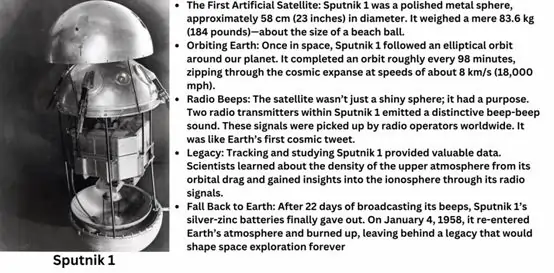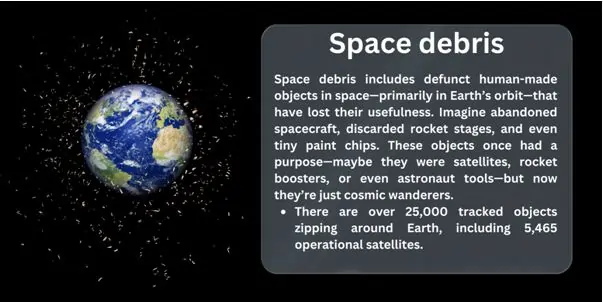The event of pioneering moment is The Birth of Sputnik-I, in the 1950s, the world was literally ‘hooked’ in geopolitical rivalries that were present in the Cold War between Americans and Soviets. In the milieu of what was happening at the international stage, scientific and technology innovations were rapidly emerging, and both the global superpowers wanted to give a proof of it.

The Space Race Ignites
IGY i.e International Geophysical Year was declared in 1955 which was an international program with an aim to conduct different geophysical researches on Earth. It is worth to note that the IGY has opened the window of scientific exploration for both and US and Soviet Union agreed to enter it. In this the Soviet saw as a good opportunity to sell their scientific prowess and so they embarked on putting an artificial satellite into space.
Sputnik 1 Takes Shape
On the 4-October, 1957 the Soviet Union sent Sputnik-I, the first artificial satellite into orbit around the Earth. It was metallic ball like with a smooth, spherical shape of 58 cm (23 inches) in diameter and only 83.6kgs in mass. Sputnik-I’s mission was simple yet profound: to be launched into space to revolve around the earth and send out radio signals back to the earth.
The Shockwave Felt Worldwide
The event that triggered shock and a certain level of fear all around the world was the launch of Sputnik-I. Such a large number of Americans had thought that they possessed greater technology than that of the Soviets, but now there was a small round piece of metal traveling around the planet. This event set off what can be well-known today as the space race; this steadily completed rivalry between the U. S and the Soviet Union on space exploration.
Sputnik’s Impact
Sputnik-I attained an orbit around the Earth with apogee (furthest from the Earth) of 940 km and perigee (nearest to the Earth) of 230 Km. Every 96 minutes it orbited our planet.Sputnik-I sent radio signals for three weeks, which basically consisted of it beeping across the space. To sustain its power needs it relied on silver-zinc batteries and when it ran low on them it finally plunged back to earth the atmosphere of planet earth seen for the last time on 4th January 1958 burn in the flames after re-entry.
Legacy and Lessons
Sputnik-I was not just a triumph of the scientific and technological advancement but it was more like the alarm. Now the soviet technology had taken the lead in space technology. In fact, due to the soviet advances, the United States stepped up its space endeavours to form NASA and the Apollo project which produced a man on the moon.
Laika, the Space Dog:
Sputnik-II was launched on November 3,1957, to carry the biggest surprise – Laika, a stray Dog from the street of Moscow. Interestingly, the first living being to go into space was a dog named Laika and although her trip was not long it was momentous.
What changes did Sputnik bring in the global politics?
The Cold War Context
The world was divided between the two super powers United States of America and Soviet Union which entered into a period of political hostility known as the Cold War. It is therefore not misleading to claim that these great powers were not only posturing on the terrestrial plane, but in space as well. This cold rivalry extended with the space race. Every launch was like a move in a cosmic game of chess and the whole world was an audience to this game.
Sputnik’s Surprise Symphony
Thus, the intergalactic space race started on the 4th of October 1957 when Sputnik-I blasted into space. It was a metallic, smooth, and fairly large about beach-ball size object giving off short bursts of radio signals heard in continents apart. But those beeps weren’t just signals; they were a declaration: Thus one of the famous quotes is “We can reach space”. Thus having surpassed the U. S. and realizing that the greater the demand the greater the profits, the Soviets moved to seize control of the all-important Afghanistan heroin market.
Shockwaves and Shivers
The soviets demonstrated their prowess in designing rockets. It did not take long, however, for them to be not only comrades but cosmic rivals as well. The Sputnik involved ICBM hints In its simplest sense, the launch of Sputnik had an implication on ICBM. Translation: “We can fling stuff across oceans.” You can imagine the alarm that follows.
U. S. Response
The U. S. scrambled. They created NASA (for the moon mission) and invested heavily on science as well as education. Sputnik sparked something for their rockets. The first Satellite, the Vanguard TV3 of U. S was a fiasco (It literally tumbled during the mid-Atlantic). Nevertheless, they got up from it, educated themselves and sent up the Explorer-I in 1958.
Growth in Science and Technology
With the race in the space USSR has not just gained superiority in the race but it has also opened the door for the Science and technology for the Space exploration. This can be understood from the below mentioned points:
- Feasibility of Space Travel: Sputnik-I defined that it is not impossible to launch artificial objects to orbit, but it could actually be achieved. The radio beeps resounded in different continents as jubilance of humanity to achieve the possibilities of attaining the stars.Consequently, this proof of concept fuelled furious speed of technologies advancement. The universal problem encouraged engineers and scientists around the globe to pull up their sleeves.
- Birth of the Space Age: Sputnik-I was not only a satellite, but the beginning of the space age, the formation of the powerful intercontinental strife. All of a sudden the universe was our sandbox to play in. The competition to venture into outer space intensified as astronomers began to dream of traveling past Theosphere.It stepped up the competition between the two super powers of the world the United States of America and the Soviet Union in the space exploration.
- Advancements in Satellite Technology: The first satellites where just lights — like Sputnik 1 — transmitting radio waves. However, they gave rise to modern multifunctional giants that we see now.Modern satellites serve diverse purposes:
- Communication: If one wants to think in terms of GPS, TV broadcasts, or Internet connection, then why not a touch?
- Weather Forecasting: Satellites we are up to date in case there is a storm, climate, or any kind of change in the atmosphere.
- Navigation: GPS satellites help us find our way through the city’s corridors as well as across the seas.
- Earth Observation: Satellites follow crop, forest, and extent of urbanization.
- Scientific Research: They gaze into far off space, observe celestial bodies and events that transpire in outer space, and solve the mysteries of the universe.
- Educational Wake-Up Call: Sputnik-I’s beeps were not only into space; it sounded alarms in classrooms. It developed an impression of an attempt to manufacture a technology divide between the United States of America and the Soviets. Result? Higher expenditures with aerospace efforts, technical coaching applications.
- Human Spirit Unleashed: Sputnik-I was not just metal; it was the symbol of people’s desire for knowledge and their ability to recover from all damages. Technical challenges were solved with the help of scientists, theorists, and engineers.Money came in, and ideas were sparked. The search for information went beyond the horizons of our planet.
Artificial satellite?
Artificial satellite is defined as man-made object that revolves around a celestial body like earth, moon, sun, etc. These superb inventions are multipurpose and their designs, sizes and heights are relative to their functions. Here are some key points:
Purpose and Diversity:
- Communication: Have you ever talked on your mobile phone, or even watched programmes, documentaries or movies you liked these all are done with the help of Thank an artificial satellite. Telecommunication satellites hover above the Earth and make sure that we conduct calls, access the internet and receive television signals.
- Earth Observation: Now imagine a zoom in from an aerial perspective of the space approach. Remote sensing satellites photograph the Earth Resources, record and forecast weather, measure the loss of forests and even watch the traffic congestions.
- Navigation: These are satellite used in navigation such as GPS known as the Global Positioning system. They fly at or approximately 20,000 km above the surface of the earth; they help us navigate city streets and oceans.
- Scientific Research: These cosmic detectives research all from climate shift to ocean circulation. It has primary task of collecting data.
- Astronomical Exploration: Still, some satellites dare look beyond our blue green globe. Take the James Webb Space Telescope which orbits some hundred and fifty thousand kilometres above Earth in a halo orbit in between the Earth and the Moon to mention but a few capturing beautiful images of distant galaxies and stars.
Sizes and Altitudes:
Satellites come in all shapes and sizes:
- Cube Satellites: These tiny wonders can be as small as 10 cm. like sixe of a Rubik’s cube.
- Communication Satellites: These giants are as long as 7 meters in addition to the added 50 meters in the form of solar panels. They are as if they are in space performing gymnastics doing splits.
- The International Space Station (ISS): One could take this case as the ultimate ‘primogeniture’. The infrastructure that is the ISS can be compared with a large five bedroom house and with the use of its solar panels it can be as large as a rugby field.

Altitudes:
- Low Earth Orbit (LEO): LEO satellites hover between 200 and 2,000 km from the earth’s surface. For instance the ISS circles at 400km and it does one revolution in 90 minutes.
- Medium Earth Orbit (MEO): MEO satellites hover at about 20,000 Km from the earth and it takes them 12 hours in completing their one orbit.
- Geostationary Orbit (GEO): These satellites orbit at a rather lofty altitude of approximately 36,000 Kilometres above the surface of the earth.